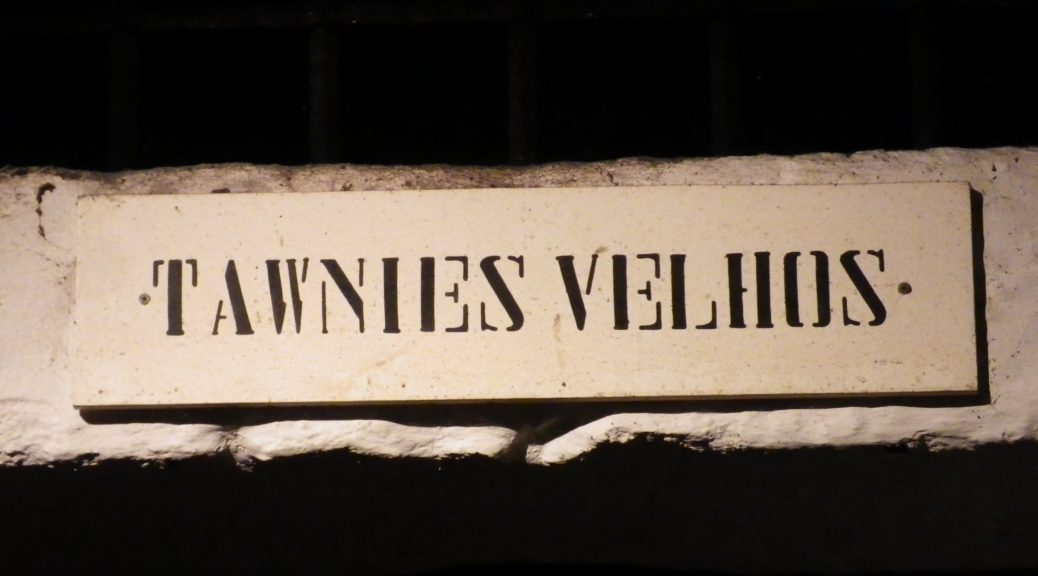What I Learned
Port is a fortified wine with its own appellation. It became known as Port because it was stored and shipped from the Portuguese town of Porto. The wine itself comes from the upper Douro region. These basic facts weave a fascinating tale of the history of Port.
Port wine begins in the upper Douro River valley. This grape growing area was one of the first in the world to be demarcated. Currently, the appellation regulations permit some 100 varietals for port production. After the harvest and some fermentation, aguardente, a brandy-like substance (but certainly not one that brandy drinkers would appreciate), is added to the wine to stop fermentation.
The resulting mix was then traditionally sent downriver, to Porto, via unique boats known as “rabelos”. (Some carefully and colorfully restored exemplars line the quays in Porto today.) Nowadays, trucks transport the wine to the lodges, specialized storage and aging facilities on the south bank of the Douro, opposite old Porto. Aging is a key factor in Port production as the wine and aguardente need time to coalesce into the velvety smooth final product that Port wine drinkers cherish.
A broad division exists within the world of Port: bottle-aged or wood-aged Ports, further delimited by the length of time it spends in either. As a consequence, several different styles of Port exist.
In order of renown, from lowest to highest, wood-aged Port styles may be Ruby, White, Tawny (bottles will often show the years of aging), Colheita (a vintage Tawny Port) or Late Bottled Vintage or LBV. This style of Port has more wood-aging than vintage Port, and may remain open longer. The bottled-aged Port styles are Vintage and Single Quinta Vintage. Vintage years/wines must be declared as exceptional by the Port and Douro Wine Institute (IVDP) authorities, so not every year is declared a vintage year. These vintage Ports may be stored for years, but must be drunk within a day of opening.
One final note: Port wine is also referred to as Porto, like the city, which itself is known in English as Oporto!
What I Tasted
Fine White Port, Graham’s: A sweet white port wine with dark gold color; a sweet, slightly floral nose, with cinnamon and dried citrus fruits flavors; medium mouthfeel.
White Port, (Branco Porto), Ferreira: A semi-sweet white port wine with dark amber gold color; a sweet spice nose, with floral, spice and toasted almond flavors; medium mouthfeel.
White Porto, Sandeman: A semi-dry port with amber gold color; a rich nose of flowers, honey, and candied citrus fruits, and nuts, honey and dried citrus flavors; very smooth with a velvety mouthfeel.
Tawny Port, Reserva Tawny Dona Antonia; Ferreira: A dry port with reddish amber brown color; nose of oak, vanilla, toasted nuts, and caramel, dried cherry toasted nuts and vanilla flavors; smooth, but somewhat hot.
Tawny Porto, Imperial Reserve, Sandeman: A dry port wine with garnet brown color; nose of dried red fruits, spice and oak, and flavors of cherries, and toasted nuts; smooth with a velvety mouthfeel.
Tawny Port, Twenty Years, W. & J. Graham’s; A dry port wine with a rich, dark golden caramel brown color; a toasted almonds and slight tobacco nose, with caramel and toasted nuts flavors; velvety mouthfeel, and very smooth.
Tawny Port, Thirty Years, W. & J. Graham’s; A dry port wine with a rich amber reddish brown color; a toasted nuts and nutmeg nose, with caramel and toasted nuts flavors; velvety mouthfeel, and oh so smooth.
